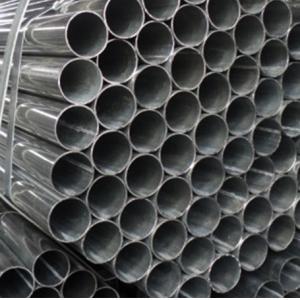
Add to Cart
Size Customized ASTM A53 Hot dip galvanized seamless pipe Water, gas and other general low pressure fluids
Hot plating seamless tube is to make molten metal and iron matrix reaction and produce alloy layer, so that the substrate and the coating of the combination of the two. Hot dip galvanizing is the first steel pipe pickling, in order to remove iron oxide on the surface of the steel pipe, pickling, through ammonium chloride or zinc chloride aqueous solution or ammonium chloride and zinc chloride mixed aqueous solution tank for cleaning, and then into the hot dip plating tank. Hot dip galvanizing has the advantages of uniform coating, strong adhesion and long service life.
Hot and cold galvanized difference
Hot dip galvanized seamless tube: complex physical and chemical reactions occur between steel tube matrix and molten plating solution to form a tightly structured zinc-iron alloy layer with corrosion resistance. Alloy layer is integrated with pure zinc layer and steel tube matrix. So its corrosion resistance is strong.
Cold galvanized seamless tube: zinc layer is electric coating, zinc layer and steel tube substrate independent layer. Zinc layer is thin, zinc layer simply attached to the steel tube substrate, easy to fall off. So its corrosion resistance is poor. It is forbidden to use cold galvanized steel pipes as water supply pipes in new residential buildings.
In the tensile process, the maximum force (Fb) of the specimen at fracture is derived from the stress (σ) of the original cross-sectional area (So) of the specimen, which is called the tensile strength (σb), expressed in N/mm2 (MPa). It represents the maximum capacity of a metal material to resist damage under tension. The calculation formula is:
Where: Fb-- the maximum force borne by the specimen when it breaks, N (Newton); So-- Original cross-sectional area of the sample, mm2.
Yield Strength
Metal materials with yield phenomenon, the specimen in the process of tensile force does not increase (keep constant) can continue to extend the stress, called the yield point. In case of force decline, upper and lower yield points should be distinguished. The unit of yield point is N/mm2 (MPa).
The upper yield point (σ SU) is the maximum stress before the specimen yields and the force drops for the first time. Lower yield point (σ SL) : the minimum stress in the yield stage when the initial transient effect is not considered.
The yield point can be calculated by:
Where Fs is the yield force (constant) of the specimen during tensile process, N (Newton) So is the original cross-sectional area of the specimen, mm2.









